| "Descrizione" about Levulose by Whiz35 (11962 pt) | 2025-Apr-01 11:24 |
| Read the full Tiiip | (Send your comment) |
Levulose, best known as Fructose is a natural sugar, a monosaccharide found naturally in fruit, vegetables, honey and is also found in breast milk.
It has 4 kcal per gram and is used as a sugar substitute in the food industry.
It is to be consumed in moderation because the chronic intake of fructose has important contraindications.
Fructose is another component with a friendly and inviting name, but whose excessive consumption can create health risks. This ingredient is often included in sweets, food drinks etc. with the aim of increasing the sweet taste and we find it in
- high-fructose corn syrup
- inverted sugar syrup (contains 36% fructose)
- glucose-fructose syrup
- fructose syrup
and also pure.

Origin. Extracted primarily from plant sources such as fruit, honey, and sugar cane or sugar beet plants.
Functions of Raw Materials.
Fruit and Honey. Provide natural fructose, known for its high sweetening power and being sweeter than glucose.
A list of fruits that are particularly high in fructose:
- Apples: Especially the sweeter varieties.
- Pears: They can sometimes even have a higher fructose content than apples.
- Watermelon: Contains a significant amount of fructose, especially given the volume that people often consume.
- Grapes: Especially the sweeter varieties like Concord and Thompson seedless.
- Mangoes: One of the sweeter tropical fruits.
- Papayas: Another tropical fruit with a high fructose content.
- Pineapples: Especially when fully ripe.
- Lychees: These small fruits pack a lot of sweetness.
- Honeydew Melon: Contains a significant amount of fructose.
- Agave Nectar: While not a fruit, it's worth noting that this sweetener, derived from the agave plant, is extremely high in fructose.
It's important to note that while these fruits are high in fructose, they also offer a range of essential nutrients, including vitamins, minerals, and fiber.
Consuming them in moderation as part of a balanced diet can offer health benefits. However, individuals with conditions like fructose malabsorption or hereditary fructose intolerance should be cautious and consult with a healthcare professional about their fruit intake.
Industrial Production Process
The industrial production of pure fructose, as opposed to high fructose corn syrup (HFCS) production, follows a specific process aimed at obtaining high-purity crystalline fructose, used in various sectors for its superior sweetening properties and low glycemic index. Here is an overview of the process:
- Extraction from Sucrose. Fructose is often industrially produced through the enzymatic hydrolysis of sucrose, a sugar composed of glucose and fructose. This process utilizes the enzyme invertase, which cleaves sucrose into an equimolar mixture of glucose and fructose.
- Purification. The liquid mixture of glucose and fructose undergoes purification processes to remove impurities and separate the two monosaccharides. Ion exchange chromatography is commonly used to separate fructose from glucose, thanks to their different affinity for the exchange resin.
- Crystallization. The purified fructose is concentrated and subjected to crystallization. This process may require controlled temperature and concentration conditions to promote the formation of fructose crystals.
- Drying. The fructose crystals are then dried to remove residual moisture, yielding pure crystalline fructose. Drying can be carried out using fluid bed dryers or spray dryers.
- Quality Control. The crystalline fructose undergoes rigorous quality control checks to verify purity, the absence of contaminants, and compliance with food specifications. This includes chromatographic analyses to determine the purity of fructose and microbiological
Form and Color
Fructose appears as a white crystal or fine powder highly soluble in water.

Studies
Added sugar is a risk factor for obesity and metabolic diseases including type 2 diabetes mellitus, cardiovascular disease, and nonalcoholic hepatic steatosis (1).
Excessive fructose consumption has been linked, at least partially, to increased adiposity and metabolic disturbances compared with other sugars that appear to be particularly important during critical periods of childhood growth and development (2).
Fructose induces oxidative stress through several mechanisms. First, because fructose is structurally different from glucose, it may promote more hepatocellular damage. Second, an overload of Fructose induces a glycation product that may interact with some proteins unfavorably. Third, an accelerated glycolytic process with fructose increases the formation of molecules such as Methylglyoxal, an agent that leads to cellular stress and altered insulin signaling (3).
There is also evidence between consumption of refined dietary sugars (fructose and glucose) and retinal diseases (4).
A recent study attributes excessive fructose intake to the progression of diabetic kidney disease (5).
As reported in a safety study of high-fructose corn syrup and fructose used as sweeteners, both showed an effect cytotoxic effect at HepG2 and human lymphocytes at higher concentrations.Both sweeteners increased the frequencies of CAs and SCEs at higher concentrations.HFCS caused DNA damage at 10% -30% concentrations.HFCS (15% and 20%) and FR (250, 1000, and 2000 μg/mL) induced MN frequency (6).
Cosmetics
Flavoring agent. The purpose of this ingredient is to modify the solution to add flavour. Natural flavouring extracts are rather expensive, so the cosmetic and pharmaceutical industries resort to synthesised substances that have sensory characteristics mostly similar to natural flavourings or are naturally equivalent. This ingredient is isolated through chemical processes or is synthesised from chemicals.
Skin conditioning agent - Humectant. Humectants are hygroscopic substances used to minimise water loss in the skin and to prevent it from drying out by facilitating faster and greater absorption of water into the stratum corneum of the epidermis. The epidermis is the most superficial of the three layers that make up the human skin (epidermis, dermis and hypodermis) and is the layer that maintains hydration in all three layers. In turn, the epidermis is composed of five layers: corneum, the most superficial, lucidum, granulosum, spinosum and basale. Humectants have the ability to retain in the stratum corneum the water they attract from the air and have the function of moisturising the skin. It is better to use them before emollients that are oil-based.
References___________________________________________________________________
(1) Welsh, J.A.; Sharma, A.; Cunningham, S.A.; Vos, M.B. Consumption of added sugars and indicators of cardiovascular disease risk among US adolescents. Circulation. 2011 Jan 25;123(3):249-57. doi: 10.1161/CIRCULATIONAHA.110.972166.
Abstract. Background: Whereas increased carbohydrate and sugar consumption has been associated with higher cardiovascular disease risk among adults, little is known about the impact of high consumption of added sugars (caloric sweeteners) among US adolescents....Conclusion: Consumption of added sugars among US adolescents is positively associated with multiple measures known to increase cardiovascular disease risk.
(2) Goran, M.I.; Dumke, K.; Bouret, S.G.; Kayser, B.; Walker, R.W.; Blumberg, B. The obesogenic effect of high fructose exposure during early development. Nat Rev Endocrinol. 2013 Aug;9(8):494-500. doi: 10.1038/nrendo.2013.108.
Abstract. Obesogens are compounds that disrupt the function and development of adipose tissue or the normal metabolism of lipids, leading to an increased risk of obesity and associated diseases. Evidence for the adverse effects of industrial and agricultural obesogens, such as tributyltin, bisphenol A and other organic pollutants is well-established. Current evidence suggests that high maternal consumption of fat promotes obesity and increased metabolic risk in offspring, but less is known about the effects of other potential nutrient obesogens. Widespread increase in dietary fructose consumption over the past 30 years is associated with chronic metabolic and endocrine disorders and alterations in feeding behaviour that promote obesity. In this Perspectives, we examine the evidence linking high intakes of fructose with altered metabolism and early obesity. We review the evidence suggesting that high fructose exposure during critical periods of development of the fetus, neonate and infant can act as an obesogen by affecting lifelong neuroendocrine function, appetite control, feeding behaviour, adipogenesis, fat distribution and metabolic systems. These changes ultimately favour the long-term development of obesity and associated metabolic risk.
Johnson RJ, Sánchez-Lozada LG, Lanaspa MA. The fructose survival hypothesis as a mechanism for unifying the various obesity hypotheses. Obesity (Silver Spring). 2023 Oct 17. doi: 10.1002/oby.23920.
(3) Prasanthi Jegatheesan and Jean-Pascal De Bandt. Fructose and NAFLD: The Multifaceted Aspects of Fructose Metabolism Nutrients 2017, 9(3), 230; doi:10.3390/nu9030230
Abstract. Among various factors, such as an unhealthy diet or a sedentarity lifestyle, excessive fructose consumption is known to favor nonalcoholic fatty liver disease (NAFLD), as fructose is both a substrate and an inducer of hepatic de novo lipogenesis. The present review presents some well-established mechanisms and new clues to better understand the pathophysiology of fructose-induced NAFLD. Beyond its lipogenic effect, fructose intake is also at the onset of hepatic inflammation and cellular stress, such as oxidative and endoplasmic stress, that are key factors contributing to the progression of simple steatosis to nonalcoholic steatohepatitis (NASH). Beyond its hepatic effects, this carbohydrate may exert direct and indirect effects at the peripheral level. Excessive fructose consumption is associated, for example, with the release by the liver of several key mediators leading to alterations in the communication between the liver and the gut, muscles, and adipose tissue and to disease aggravation. These multifaceted aspects of fructose properties are in part specific to fructose, but are also shared in part with sucrose and glucose present in energy- dense beverages and foods. All these aspects must be taken into account in the development of new therapeutic strategies and thereby to better prevent NAFLD.
(4) Kearney FM, Fagan XJ, Al-Qureshi S. Review of the role of refined dietary sugars (fructose and glucose) in the genesis of retinal disease. Clin Exp Ophthalmol. 2014 Aug;42(6):564-73. doi: 10.1111/ceo.12290.
(5) Tsuruta H, Yasuda-Yamahara M, Yoshibayashi M, Kuwagata S, Yamahara K, Tanaka-Sasaki Y, Chin-Kanasaki M, Matsumoto S, Ema M, Kume S. Fructose overconsumption accelerates renal dysfunction with aberrant glomerular endothelial-mesangial cell interactions in db/db mice. Biochim Biophys Acta Mol Basis Dis. 2024 Feb 13;1870(4):167074. doi: 10.1016/j.bbadis.2024.167074.
Abstract. For the advancement of DKD treatment, identifying unrecognized residual risk factors is essential. We explored the impact of obesity diversity derived from different carbohydrate qualities, with an emphasis on the increasing trend of excessive fructose consumption and its effect on DKD progression. In this study, we utilized db/db mice to establish a novel diabetic model characterized by fructose overconsumption, aiming to uncover the underlying mechanisms of renal damage. Compared to the control diet group, the fructose-fed db/db mice exhibited more pronounced obesity yet demonstrated milder glucose intolerance. Plasma cystatin C levels were elevated in the fructose model compared to the control, and this elevation was accompanied by enhanced glomerular sclerosis, even though albuminuria levels and tubular lesions were comparable. Single-cell RNA sequencing of the whole kidney highlighted an increase in Lrg1 in glomerular endothelial cells (GECs) in the fructose model, which appeared to drive mesangial fibrosis through enhanced TGF-β1 signaling. Our findings suggest that excessive fructose intake exacerbates diabetic kidney disease progression, mediated by aberrant Lrg1-driven crosstalk between GECs and mesangial cells.
(6) Bülbül SN, Mamur S, Yuzbasioglu D, Unal F. Safety Assessment of High Fructose Corn Syrup and Fructose Used as Sweeteners in Foods. Toxicol Mech Methods. 2024 Feb 12:1-19. doi: 10.1080/15376516.2024.2318570.
Abstract. High Fructose Corn Syrup (HFCS) and Fructose (FR) are widely used sweeteners in many foods and beverages. This study aimed at investigating the cytotoxic effects of HFCS (5%-30%) and FR (62.5-2000 μg/mL) using MTT assay in Human Hepatocellular Carcinoma (HepG2) cells, and genotoxic effects of using Chromosome Aberrations (CAs), Sister Chromatid Exchanges (SCEs), Micronuclei (MN) and comet assays in human lymphocytes. HFCS significantly reduced the cell viability in HepG2 cells at between 7.5% and 30% for 24 and 48 hours. 30% HFCS caused a very significant toxic effect. FR had a cytotoxic effect in HepG2 cells at all treatments. However, as fructose concentration decreased, the cell viability decreased. HFCS (10%-20%) and FR (250-2000 μg/mL) decreased the mitotic index at higher concentrations. IC50 value was found to be a 15% for 48 h. IC50 value of FR was detected as 62.5 μg/mL for 24 h and 48 h. HFCS significantly increased CAs frequency at 15% and 20%. FR significantly increased the frequency of CAs at 250, 1000, and 2000 μg/mL for 48 h. Both sweeteners increased the frequency of SCEs at all concentrations. HFCS (15% and 20%) and FR (250, 1000, and 2000 μg/mL) induced MN frequency at higher concentrations. HFCS caused DNA damage in comet assay at 10% -30%. FR increased tail intensity and moment at 125-2000 μg/mL and tail length at 62.5, 250 and 500 μg/mL. Therefore, HFCS and FR are clearly seen to be cytotoxic and genotoxic, especially at higher concentrations.
| Sign up to vote this object, vote his reviews and to contribute to Tiiips.EvaluateClose | (0 comments) |
| "Descrizione" about Dipotassium tartrate Review Consensus 10 by Whiz35 (11962 pt) | 2023-Oct-10 16:30 |
| Read the full Tiiip | (Send your comment) |
Dipotassium tartrate a potassium salt of tartaric acid and bears the chemical formula K2(C4H4O6).
Il nome definisce la struttura della molecola.
- Dipotassium. "Di" indica la presenza di due atomi di un elemento, in questo caso, il potassio (K). Il potassio è un minerale essenziale che svolge un ruolo chiave in molte funzioni cellulari.
- Tartrate si riferisce al sale o all'estere dell'acido tartarico. L'acido tartarico è un acido organico che si trova in natura, ad esempio, nelle uve, ed è spesso utilizzato in cucina e in enologia.
Raw materials used in production.
- Key raw materials for the production of dipotassium tartrate include tartaric acid and potassium carbonate or potassium oxide.
Step-by-step summary of industrial production process.
- Tartaric Acid Extraction. Tartaric acid can be extracted from natural sources such as deposits found in wine barrels, or it can be synthesized.
- Neutralization. Tartaric acid is neutralized with a potassium base, such as potassium carbonate or potassium oxide, to form the potassium salt.
- Crystallization. The dipotassium tartrate solution is then cooled to allow crystals to form.
- Purification. The crystals are purified through various methods, such as recrystallization.
- Drying. The crystals are then dried to remove any remaining water.
Form and color. Potassium tartrate appears as white or colorless crystalline powder.

What it is used for and where
Food
Ingredient listed in the European food additives list as E336, acidity regulator.
Food Additive. Used as a stabilizer, pH regulator, and leavening agent in food and beverages.
Baking Products. Often used in baking products as a leavening agent, especially in combination with baking soda.
Wine. Used in the wine-making process to stabilize tartrate crystals.
It is also known as cream of tartar when used in cooking, particularly in the preparation of cakes and baked goods. It is soluble in water and has a slightly acidic taste. As a salt of tartaric acid, potassium tartarate has a variety of uses in the food and other industries, taking advantage of its stabilizing, pH-regulating and leavening properties. It is also a key component in some homemade wine-making kits, where it helps control crystal formation during the fermentation and aging process.
Pharmaceuticals
May be used in the manufacturing of pharmaceutical products as a stabilizing agent and for other purposes.
Cosmetics
Buffering agent. It is an iingredient that can bring an alkaline or acid solution to a certain pH level and prevent it from changing, in practice a pH stabiliser that can effectively resist instability and pH change.
Safety
Tartaric acid (E 334), sodium tartrates (E 335), potassium tartrates (E 336), sodium potassium tartrate (E 337) and calcium tartrate (E 354) are authorised as food additives according to Regulation (EC) No 1333/2008 on food additives. The Panel established a group ADI for l(+)‐tartaric acid and tartrates (E 334-337 and E 354) of 240 mg/kg bw per day, expressed as tartaric acid, by applying the total uncertainty factor of 10 to the reference point of 3,100 mg sodium tartrate/kg bw per day (the highest dose tested), that is approximately 2,440 mg tartaric acid/kg bw per day. Accordingly, the current ADI of 30 mg/kg bw per day is withdrawn (1).
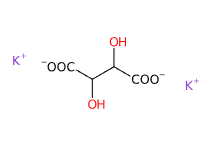 | 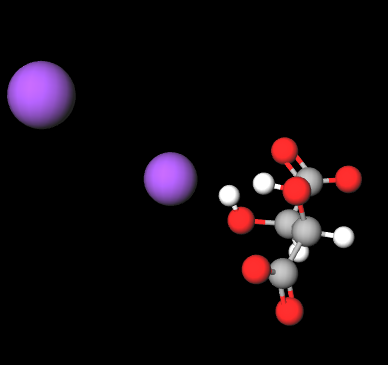 |
- Molecular Formula C4H4K2O6
- Molecular Weight 226.27
- CAS 921-53-9
- UNII O9WLL1ZL8S
- EC Number 203-490-6
- DSSTox ID DTXSID90889442
- IUPAC dipotassium;(2R,3R)-2,3-dihydroxybutanedioate
- InChl=1S/C4H6O6.2K/c5-1(3(7)8)2(6)4(9)10;;/h1-2,5-6H,(H,7,8)(H,9,10);;/q;2*+1/p-2/t1-,2-;;/m1../s1
- InChl Key AVTYONGGKAJVTE-OLXYHTOASA-L
- SMILES C(C(C(=O)[O-])O)(C(=O)[O-])O.[K+].[K+]
- MDL number MFCD00013065
- ChEBI 63018
- Nikkaji J7.170F
Synonyms:
- PotassiumD-tartratemonobasic
- Dipotassium tartrate
- Potassium tartrates
References_____________________________________________________________________
(1) EFSA Panel on Food Additives and Flavourings (FAF); Younes M, Aquilina G, Castle L, Engel KH, Fowler P, Frutos Fernandez MJ, Fürst P, Gürtler R, Gundert-Remy U, Husøy T, Mennes W, Shah R, Waalkens-Berendsen I, Wölfle D, Boon P, Tobback P, Wright M, Aguilera J, Rincon AM, Tard A, Moldeus P. Re-evaluation of l(+)-tartaric acid (E 334), sodium tartrates (E 335), potassium tartrates (E 336), potassium sodium tartrate (E 337) and calcium tartrate (E 354) as food additives. EFSA J. 2020 Mar 11;18(3):e06030. doi: 10.2903/j.efsa.2020.6030.
| Sign up to vote this object, vote his reviews and to contribute to Tiiips.EvaluateClose | (0 comments) |
| "Descrizione" about Vegetable glycerin by Whiz35 (11962 pt) | 2023-Oct-10 10:56 |
| Read the full Tiiip | (Send your comment) |
Vegetable glycerin
Glycerin (Glycerine). Trivalent alcohol, hygroscopic. Glycerin is the trade name when the percentage of glycerol is 95%, but the names Glycerin and Glycerol are mostly used to identify the same product. In practice: the pure chemical component is called glycerol, while glycerine contains about 95% glycerol.
Raw materials used in production.
Glycerin can be produced from various lipids (in this case fats and oils), and it is also obtained as a byproduct in the production of biodiesel and soap.
Step-by-step summary of industrial production process.
- Extraction or Synthesis. Glycerin can be obtained from saponification of fats (soap-making process).
- Refining. Crude glycerin is purified through a process that includes distillation and treating with activated carbon to remove impurities.
- Distillation. To achieve USP-grade or food-grade glycerin, the product must be distilled.
It occurs as an odourless, colourless to brown viscous liquid. Insoluble in chloroform, ether, carbon disulphide, benzene, oil. Miscible with ethanol and water. Can absorb moisture from the air as well as other volatile chemicals such as hydrogen sulphide, hydrogen cyanide and sulphur dioxide.
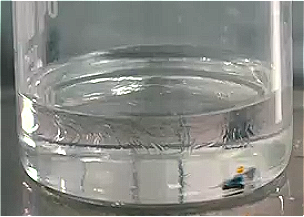
What it is used for and where it is used
There are approximately 1,600 applications for glycerol.
Food
Hygroscopic agent, emulsifier, sweetener and solvent.
Military
Preparation of nitroglycerine, an explosive. Anticorrosive agent
Pharmaceutical
Syrups, suppository ointments as humectant, lubricant. Inserted in medicinal tablets as a humectant and flow agent.
Cosmetics
Its water solubility, hygroscopicity and hydrophilicity characteristics give glycerine humectant and moisturising capacities that are of great importance in most topical cosmetic applications. It attracts water to the surface of the skin and in this way maintains the hydration of the stratum corneum. By improving skin texture, it acts as a skin barrier. In cleansers, shampoos and other cosmetic products, it is included in the formula with the aim of moisturising and softening the skin, preserving it from ageing or roughness. It is also used in toothpastes as a humectant and to protect gum and tooth tissue.
Classic glycerine acts in cosmetic formulations in a number of useful ways, which I list in alphabetical order.
Denaturant. The ionic or polar molecules of this ingredient included in formulations that interact with protein groups, modulate the properties of the solution to suit specific needs.
Hair conditioning agent. A large number of ingredients with specific purposes can co-exist in a hair shampoo: cleansers, conditioners, thickeners, mattifying agents, sequestering agents, fragrances, preservatives, special additives. However, the indispensable ingredients are the cleansers and conditioners as they are necessary and sufficient for hair cleansing and manageability. The others act as commercial and non-essential auxiliaries such as: appearance, fragrance, colouring, etc. Hair conditioning agents have the task of increasing shine, manageability and volume, and reducing static electricity, especially after treatments such as colouring, ironing, waving, drying and brushing. They are, in practice, dispersing agents that may contain cationic surfactants, thickeners, emollients, polymers. The typology of hair conditioners includes: intensive conditioners, instant conditioners, thickening conditioners, drying conditioners.
Humectant. Hygroscopic compound used to minimise water loss in the skin and to prevent it from drying out by facilitating faster and greater absorption of water into the stratum corneum of the epidermis. The epidermis is the most superficial of the three layers that make up human skin (epidermis, dermis and hypodermis) and is the layer that maintains hydration in all three layers. In turn, the epidermis is composed of five layers: horny, the most superficial, granular, spinous, shiny, and basal. Humectants have the ability to retain the water they attract from the air in the stratum corneum and have the function of moisturising the skin. They are best used before emollients, which are oil-based.
Oral care agent. This ingredient can be placed in the oral cavity to improve and/or maintain oral hygiene and health, to prevent or improve a disorder of the teeth, gums, mucous membrane.
Fragrance. It plays a very important role in the formulation of cosmetic products as it allows perfume to be enhanced, masked or added to the final product, improving its commercial viability. The consumer always expects to find a pleasant scent in a cosmetic product.
Skin conditioning agent. It is the mainstay of topical skin treatment by restoring, increasing or improving skin tolerance to external factors, including melanocyte tolerance. The most important function of the conditioning agent is to prevent skin dehydration, but the subject is rather complex and involves emollients and humectants.
Skin protectant. It creates a protective barrier on the skin to defend it from harmful substances, irritants, allergens, pathogens that can cause various inflammatory conditions. These products can also improve the natural skin barrier and in most cases more than one is needed to achieve an effective result.
Solvent. It is the substance for dissolving or dispersing surfactants, oils, dyes, flavourings, bactericidal preservatives in solution.
Viscosity control agent. It controls and adapts viscosity to the required level for optimal chemical and physical stability of the product and dosage in gels, suspensions, emulsions, solutions.
Textile industry
Finishing techniques, co-solvent, dispersant, moisture absorbent. Wetting agent, hygroscopic agent, anti-shrinkage treatment of fabrics.
Coatings
Alkyd resin (modified thermosetting polyester), polyester resin, epoxy resin and glycidyl ether. and also: papermaking, in leather, photography, metalworking, rubber, printing and dyeing, antifreeze in lubricants and the petroleum sector
For more information:
Typical optimal commercial product characteristics Glycerol
| Appearance | Colorless to brown colored liquid |
| Boiling Point | 290.0±0.0 °C at 760 mmHg |
| Melting Point | 17.8℃(18.17℃,20℃) |
| Density | 1.3±0.1 g/cm3 1.26331 (20 ºC) |
| pH | 5.5-8 (25℃, 5M in H2O) |
| Flash Point | 160.0±0.0 °C |
| Relative vapor density (air = 1) | 3.1 |
| Viscosity (20 ºC) : 1412 mpa. S (25 ºC) | 945 mpa. S |
| Surface tension (20 ºC) | 63.3 mN/m |
| Saturated vapor pressure (kPa) | 0.4 (20 ºC) |
| Ignition temperature | 370° |
| Volume expansion coefficient/K - 1 | 0.000615 |
| Saponification equivalent | ≤5mg/kg |
| Heavy metals | ≤2mg/kg |
| Refractive Index | 1.47547~1.4730 |
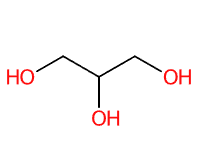 | 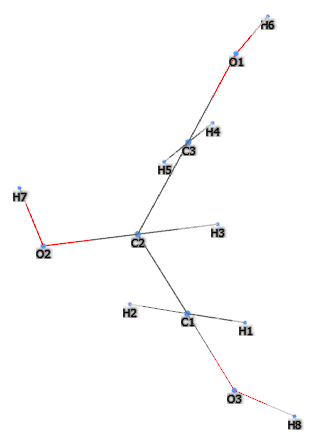 |
 | 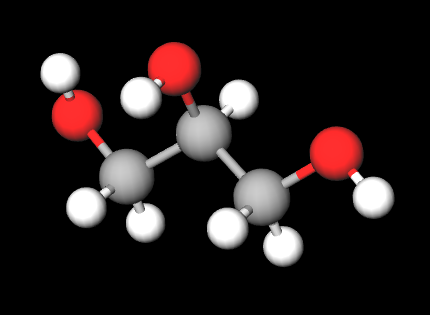 |
- Molecular Formula : C3H8O3 CH2OH-CHOH-CH2OH
- Linear Formula : HOCH2CH(OH)CH2OH
- PMolecular Weight : 92.094 g/mol
- Exact Mass 92.047340
- CAS : 56-81-5 8043-29-6 25618-55-7 8013-25-0
- UNII PDC6A3C0OX
- EC Number: 200-289-5
- MDL number: MFCD00004722
- PubChem Substance ID: 24895216
- DSSTox Substance ID DTXSID9020663 DTXSID4020662
- IUPAC propane-1,2,3-triol
- InChI=1S/C3H8O3/c4-1-3(6)2-5/h3-6H,1-2H2
- InChl Key PEDCQBHIVMGVHV-UHFFFAOYSA-N
- SMILES C(C(CO)O)O
- ChEBI 17754
- ICSC 0624
- NSC 759633 9230
- RTECS MA8050000
- NCI C29077
Synonyms:
- Glycerin
- Glycerine
- Glycyl alcohol
- 1,2,3-trihydroxypropane
- 1,2,3-Propanetriol
- Synthetic glycerin
- Polyglycerine
| Sign up to vote this object, vote his reviews and to contribute to Tiiips.EvaluateClose | (0 comments) |
| "Descrizione" about Flavorings Review Consensus 8 by Whiz35 (11962 pt) | 2023-Oct-09 10:47 |
| Read the full Tiiip | (Send your comment) |
Flavorings is a generic term used to describe substances that give a particular taste or aroma to foods. The consumer cannot know the composition of this ingredient.
Description of raw materials used in production.
- Flavorings can come from a variety of sources, including natural substances like fruit extracts, spices, herbs, and synthetic compounds created in a lab to emulate or enhance specific flavors.
Step-by-step summary of industrial production process.
- Extraction/Creation. Natural flavorings are often extracted from plants, while artificial ones are created through chemical processes.
- Purification. Purification is a key step to ensure that the flavoring is safe and adheres to food standards.
- Mixing. Often flavorings are combined or blended to create desired flavor profiles.
- Standardization. Flavorings are standardized to ensure consistency across different production batches.
Form and color.
Flavorings can come in various forms - liquid, powder, granulated, etc. - and colors, depending on their origin and production method.
Commercial applications.
Flavorings are used across a wide range of food products and beverages to enhance, modify, or create a particular flavor.
Food Industry. Flavorings are widely used to enhance or modify the taste and/or smell of foods. They can be natural, artificial, or nature-identical.
Beverage Industry. Flavorings are crucial in creating taste profiles in beverages like juices, sodas, liquors, and more.
Cosmetic Industry. Used to impart a pleasing scent to products like creams, lotions, soaps, and broadly personal care items.
Pharmaceutical. Flavorings are used to mask unpleasant tastes in medicines, especially in pediatric formulations.
Safety
Flavorings, both natural and artificial, are generally recognized as safe when used in recommended amounts.
Flavorings may contain various compounds, including esters, alcohols, and terpenes, which provide specific tastes and smells and some individuals may be allergic or sensitive to certain flavorings and may experience adverse reactions when consuming products that contain them.
| Sign up to vote this object, vote his reviews and to contribute to Tiiips.EvaluateClose | (0 comments) |
| "Descrizione" about Flavoring Review Consensus 8 by Whiz35 (11962 pt) | 2023-Oct-09 10:38 |
| Read the full Tiiip | (Send your comment) |
Flavoring is a generic term used to describe substances that give a particular taste or aroma to foods. The consumer cannot know the composition of this ingredient.
Description of raw materials used in production.
- Flavorings can come from a variety of sources, including natural substances like fruit extracts, spices, herbs, and synthetic compounds created in a lab to emulate or enhance specific flavors.
Step-by-step summary of industrial production process.
- Extraction/Creation. Natural flavorings are often extracted from plants, while artificial ones are created through chemical processes.
- Purification. Purification is a key step to ensure that the flavoring is safe and adheres to food standards.
- Mixing. Often flavorings are combined or blended to create desired flavor profiles.
- Standardization. Flavorings are standardized to ensure consistency across different production batches.
Form and color.
Flavorings can come in various forms - liquid, powder, granulated, etc. - and colors, depending on their origin and production method.
Commercial applications.
Flavorings are used across a wide range of food products and beverages to enhance, modify, or create a particular flavor.
Food Industry. Flavorings are widely used to enhance or modify the taste and/or smell of foods. They can be natural, artificial, or nature-identical.
Beverage Industry. Flavorings are crucial in creating taste profiles in beverages like juices, sodas, liquors, and more.
Cosmetic Industry. Used to impart a pleasing scent to products like creams, lotions, soaps, and broadly personal care items.
Pharmaceutical. Flavorings are used to mask unpleasant tastes in medicines, especially in pediatric formulations.
Safety
Flavorings, both natural and artificial, are generally recognized as safe when used in recommended amounts.
Flavorings may contain various compounds, including esters, alcohols, and terpenes, which provide specific tastes and smells and some individuals may be allergic or sensitive to certain flavorings and may experience adverse reactions when consuming products that contain them.
| Sign up to vote this object, vote his reviews and to contribute to Tiiips.EvaluateClose | (0 comments) |
| "Descrizione" about Vanilla Aroma Review Consensus 8 by Whiz35 (11962 pt) | 2023-Oct-07 21:31 |
| Read the full Tiiip | (Send your comment) |
Vanilla Aroma
The name describes the structure of the molecule.
- Vanilla aroma does not directly derive from the vanilla plant and can be comprised of various chemical compounds that recreate the taste and aroma of vanilla, such as synthetic vanillin.
Description of raw materials used in production.
- The primary raw material for artificial vanilla flavor is synthetic vanillin, which can be derived from lignin (a plant polymer) or chemically synthesized from precursors like guaiacol or eugenol.
Step-by-step summary of industrial chemical synthesis process.
- Vanillin Synthesis. Vanillin can be synthesized using several methods, including converting eugenol (extracted from cloves) or via derivation from lignin during pulp production.
- Flavor Creation. The synthesized vanillin is then blended with other chemical compounds or flavors to create a more complex aromatic profile resembling natural vanilla.
- Dilution and Standardization. The flavor is diluted and standardized to ensure consistency and safety in the final product.
- Packaging. The flavor is then packaged into suitable containers and distributed to food and beverage manufacturers.
Form and color.
Artificial vanilla flavors are generally liquid and can range from colorless to pale yellow.

Commercial applications.
Widely used in the food and beverage industry in products like baked goods, beverages, ice cream, and many other products that require a vanilla flavor without using the natural extract, which is significantly more costly.
| Sign up to vote this object, vote his reviews and to contribute to Tiiips.EvaluateClose | (0 comments) |
| "Descrizione" about Sodium Hydrogen Carbonate Review Consensus 10 by Whiz35 (11962 pt) | 2023-Oct-07 21:24 |
| Read the full Tiiip | (Send your comment) |
Sodium Hydrogen Carbonate (bicarbonate of soda) is a chemical compound with the formula NaHCO3, commonly also known as baking soda. It is a sodium salt of carbonic acid and is known for its numerous applications, including use in cooking as a leavening agent and in medicine as an antacid.
The name describes the structure of the molecule.
- Sodium is a chemical element and an essential mineral for the human body, involved in many cellular and physiological functions.
- Hydrogen is the lightest and most abundant chemical element in the universe.
- Carbonate is a salt of carbonic acid characterized by the presence of the carbonate anion, CO3^2-.
Description of raw materials used in production.
- Raw materials for producing sodium bicarbonate include sodium carbonate, water, and carbon dioxide.
Step-by-step summary of industrial production process.
- Ammonia. Sodium carbonate is first dissolved in water and subsequently reacts with ammonia.
- Reaction with carbon dioxide. Ammonia, carbon dioxide, and sodium carbonate react, forming ammonium bicarbonate and sodium bicarbonate.
- Precipitation. Sodium bicarbonate precipitates from the solution, while ammonium bicarbonate remains dissolved.
- Separation and purification. The precipitated sodium bicarbonate is then separated, washed, and purified.
- Drying. After purification, the sodium bicarbonate is dried and can be milled into a fine powder for various industrial applications.
Form and color.
Sodium bicarbonate appears as a white crystalline powder.

Commercial applications.
Sodium bicarbonate is used across various industries, including the food industry as a leavening agent, household cleaning, personal care in bath and mouth products, and in industrial and medicinal applications to neutralize acids.
Food Use. Sodium bicarbonate, also known as baking soda, is widely used as a leavening agent in baked goods such as cakes and bread.
Cleaning Products. This compound is a common ingredient in many cleaners and cleaning products due to its scrubbing and deodorizing properties.
Personal Care. It can be found in some personal hygiene products like toothpaste and deodorants due to its antibacterial and neutralizing properties.
Medicine. Sodium bicarbonate is also used to treat heartburn and acid reflux by neutralizing stomach acid.
Industrial Use. In industry, it is used in production and cleaning processes.
Cosmetics
Abrasive agent. It contains abrasive particles to remove stains or biofilm that accumulate on the stratum corneum or teeth. Baking soda, kieselguhr, silica and many others have abrasive properties. Peeling or exfoliating products used in dermatology or cosmetic applications contain abrasive agents in the form of synthetic microspheres, however these microspheres or abrasive particles are not biodegradable and create pollution in aquatic ecosystems.
Buffering agent. It is an iingredient that can bring an alkaline or acid solution to a certain pH level and prevent it from changing, in practice a pH stabiliser that can effectively resist instability and pH change.
Deodorant agent. When substances that give off an unpleasant odour are included in cosmetic formulations (typical examples are methyl mercaptan and hydrogen sulphide derived from garlic), deodorants attenuate or eliminate the unpleasant exhalation. It helps counteract the formation of bad odours on body surfaces.
Oral care agent. This ingredient can be placed in the oral cavity to improve and/or maintain oral hygiene and health, to prevent or improve a disorder of the teeth, gums, mucous membrane. It provides cosmetic effects to the oral cavity as a protector, cleanser, deodorant.
Skin protectant. It creates a protective barrier on the skin to defend it from harmful substances, irritants, allergens, pathogens that can cause various inflammatory conditions. These products can also improve the natural skin barrier and in most cases more than one is needed to achieve an effective result.
 |  |
- Molecular Formula CHNaO3
- Molecular Weight 84.007 g/mol
- CAS 144-55-8
- UNII 8MDF5V39QO
- EC Number 205-633-8
- DTXSID9021269
| Sign up to vote this object, vote his reviews and to contribute to Tiiips.EvaluateClose | (0 comments) |
Read other Tiiips in __Italiano (395)

